

How+To+Write+A+Great+Feature+Article.pdf. How+To+Write+A+Great+Feature+Article.pdf. End of the year EESL Exam sec IV Note SheetName. Censored! - Go Ask Alice and Censorship. Teaching Controversy. By Moira Wong and Josh Bloch One alternative to banning controversial publications in schools is to provide students with the tools to think critically about difficult and divisive issues.
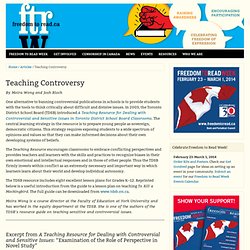
In 2003, the Toronto District School Board (TDSB) introduced A Teaching Resource for Dealing with Controversial and Sensitive Issues in Toronto District School Board Classrooms. The central learning strategy in the resource is to prepare young people as sovereign, democratic citizens. This strategy requires exposing students to a wide spectrum of opinions and values so that they can make informed decisions about their own developing systems of beliefs. The Teaching Resource encourages classrooms to embrace conflicting perspectives and provides teachers and learners with the skills and practices to recognize biases in their own emotional and intellectual responses and in those of other people.
The TDSB resource includes eight excellent lesson plans for Grades K–12. Reproduced with permission. Banned Books That Shaped America. The Library of Congress created an exhibit, "Books that Shaped America," that explores books that "have had a profound effect on American life.
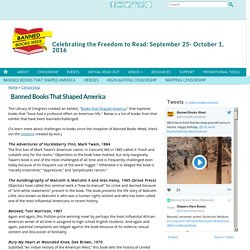
" Below is a list of books from that exhibit that have been banned/challenged. Against Banning Books. The Catcher in the Rye.
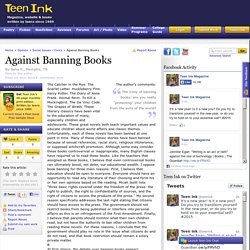
The Scarlet Letter. Huckleberry Finn. Harry Potter. The Diary of Anne Frank. Animal Farm. Banned Books: A School Librarian's Perspective. Many years ago, when I began my teaching career in a small rural high school, the library was in a cage.

Literally. The books were all locked inside a large metal cage in the corner of a study hall, and that was the library. At that time the library was staffed only one or two days a week, and I suppose it was considered necessary to lock it up for security. Molly Raphael: Banned Books Week Reminds Us That Censorship Is Alive and Well in the Internet Age. The week of Sept 24 - Oct 1 is Banned Books Week, a time when libraries, schools, and bookstores celebrate our First Amendment freedom to read while drawing attention to the harms that censorship does to our society and our individual freedoms.
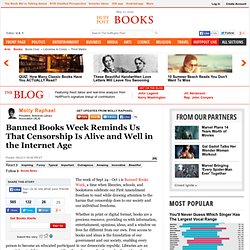
Whether in print or digital format, books are a precious resource, providing us with information, entertainment, opinions, ideas, and a window on lives far different from our own. Free access to books and ideas is the foundation of our government and our society, enabling every person to become an educated participant in our democratic republic. Libraries are an essential part of this process, providing the only access for those who do not have the resources to purchase or access books and information on their own.
It's become popular in the last few years to argue that this kind of book censorship is no big deal. What Banned Books Mean to Parents & Kids. N/a Kids and curiosity go together.
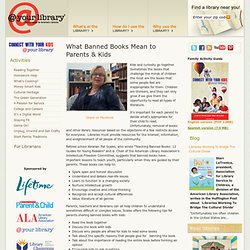
Sometimes the books that challenge the minds of children the most are the books that some people feel are inappropriate for them. Children are thinkers, and they can only grow if we give them the opportunity to read all types of literature. It's important for each parent to decide what's appropriate for their child to read. Unfortunately, removal of books and other library resources based on the objections of a few restricts access for everyone. Retired school librarian Pat Scales, who wrote "Teaching Banned Books: 12 Guides for Young Readers" and is Chair of the American Library Association's Intellectual Freedom Committee, suggests that banned books have important lessons to teach youth, particularly when they are guided by their parents. Parents, teachers and librarians can all help children to understand sometimes difficult or complex issues. Why I Read Banned Books to My Children.
The world is a big place with a lot of different viewpoints, ideologies, religious practices, and beliefs, and children's books -- like all literature -- reflect the world around us.
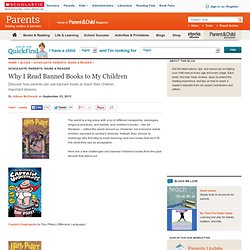
However, not everyone wants children exposed to society's diversity. Instead, they choose to challenge (the first step to book banning) and ban books that don't fit into what they see as acceptable. Here are a few challenged and banned children's books from the past decade that stand out: Captain Underpants by Dav Pilkey (Offensive Language) Faculty.etsu.edu/odonnell/2013fall/engl3130/student_essays/banned_books.pdf. Raynor Memorial Libraries. The Awakening (1899) Kate Chopin The Awakening (1899), by Kate Chopin, is the story of Edna, a woman who falls in love with a young man while vacationing with her husband and two children.

Once the vacation is over, Edna is left with her "unorthodox" thoughts on femininity, motherhood, and marriage.1 The novel was very controversial at the time of its publication. Critics were offended by the portrayal of female sexual desire and the work was banned from Chopin's hometown public library.2 In 2006, The Awakening, along with eight other titles, was challenged by a school board member in Illinois, who wanted the books off the high school's reading list.3 References: Ulysses (1918) James Joyce Ulysses (1918), by James Joyce, takes place on one day, June 16, 1904, and relates the thoughts, feelings, words, and actions of Leopold Bloom, his wife Molly, and Stephen Dedalus.
Top 100 Banned/Challenged Books: 2000-2009. M.wdsu. Censorship & Banned Books by Spencer Chung on Prezi.